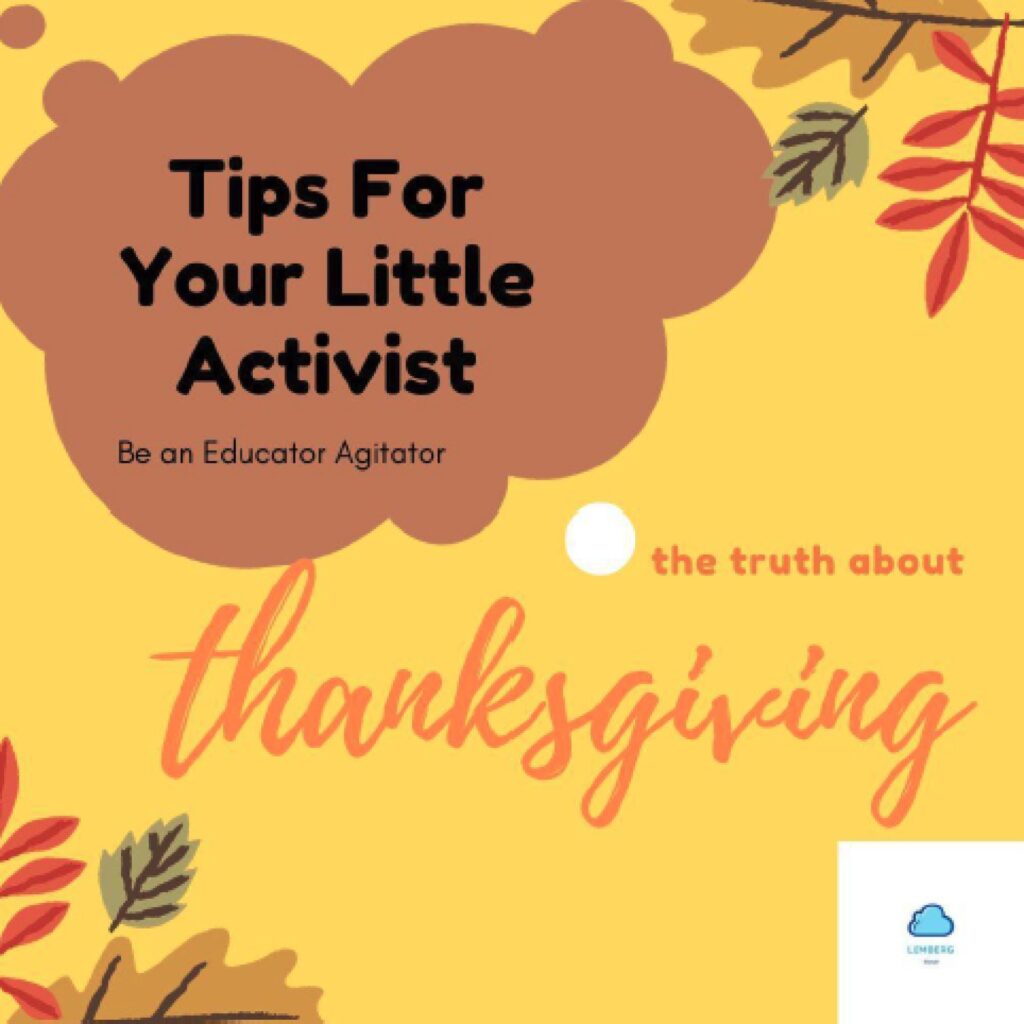Teaching The Truth About Thanksgiving
AGE-APPROPRIATE ENGAGEMENT
Here are some suggestions for engaging kids of all ages with Thanksgiving and Native American culture.
“There’s no reason we can’t have really fun, interactive, and accurate lessons around Thanksgiving.” – National Education Association
(+) = these resources can work with this age group or above in many circumstances. Not necessarily limited to the age group it is presented in.
INFANTS/TODDLERS(+):
Expose your children to songs, art, images, stories, people, etc that have accurate representations of Native Americans, showing narratives of indigenous peoples in the past and present.
Check Out: Molly of Denali’s “The Big Gathering” Videos; Gitige: She/He Gardens (by Fond du Lac); May We Have Enough To Share (By Richard Van Camp)
After you watch Molly of Denali’s “The Big Gathering” Series, check out “The Big Gathering Game” on PBSkids.org and their activity called “Celebrate Family Traditions’
TODDLERS/PRESCHOOLERS(+):
Focus on Food, the Land, and how Native Americans have protected and lived on the land.
Check Out: Molly of Denali (PBS kids), Nibi is Water (By Joanne Robertson), Fry Bread (By Kevin Noble Maillard)
After you watch Molly of Denali, check out their “Field Guide to Birds” resource and “Make A Nature Journal to Observe Animals” activity
EARLY/MIDDLE ELEMENTARY(+):
Whose land are we on? Engaging with the Native people, cultures, and traditions in your local and state communities, past, present, and future. And acknowledging the full picture that yes thanksgiving happened and there was a feast with Native Americans and European settlers, but that is not a representation of all encounters with native Americans and there was real tension present as well as civility.
Check Out: Sing The Water Song Video, Sing The Water Song Website, & We are
Water Protectors; The Three Sisters, We are Grateful: Otsaliheliga by Traci Sorell, The Children of the Morning Light: Wampanoag Tales by Manitonquat (Medicine Story); Giving Thanks: A Native American Good Morning Message (By Jake Swamp)
Native Land Maps
https://www.tribalnationsmaps.com/
Check out Molly of Denali’s activity on how to “Design a Poster to Honor the Indigenous Lands You Live On” and Tinkergarten’s “How (& Why) to Help Kids Learn About the Original Caretakers of the Lands We Explore”
MIDDLE/LATE ELEMENTARY(+):
Engaging with primary sources, curiosity mindset, inquiry, investigation, – what do we know about Thanksgiving? What do we not know? What have you learned about Thanksgiving and Native Americans, where have you learned it, and how do you know it is true? opportunity to talk about perspective and point of view.
Check Out: I Can Make This Promise; Activities in the Smithsonian PD video (Edward Winslow’s Eyewitness Account, Wampum Belt, and J.L. Ferris painting); https://youarethehistorian.org/; Thanksgiving lessons include Native American views (video via Associated Press)
MIDDLE/HIGH SCHOOL(+):
Discussing Myth vs Fact and critical thinking-By this age, students are ready to fully engage with the history of genocide and the violence of colonization.
Check Out: Indigenous Peoples’ History of the United States by Roxanne Dunbar-Ortiz
N.E.R.D.S Framework (Name the Problem. Educate Yourself. Reframe It. Dream Up Solutions. Start to Act.) – Kira Banks, Ph.D. (co-founder of Raising Equity) via Marnie Shwartz on Maisonette
Thinking About Thanksgiving
Some Suggestions for Learning and Unlearning
What are we teaching our students about Thanksgiving, Native Americans, and colonization?
- TEACH NATIVE HISTORY AND CULTURE ALL YEAR:
Teaching with specificity; Native history is American history; Teaching there are still native folks now (past present and future); Making safety & accurate representation of native people for native students, communities, and families a priority.
In terms of Thanksgiving, we can “Replace “Indians” and “Pilgrims” with more specific names: Wampanoag and English or Separatists. As responsible educators, we need to encourage our students to use more accurate terms.” – Sabrina Holcomb, National Education Association Ed Justice
Tinkergarten has an article about “Including Ongoing Learning about Native Peoples’ Connection to the Land on Your Outdoor Adventures”
- ENGAGING WITH VARIOUS NATIVE VOICES AND PERSPECTIVES:
Acknowledging differences in how indigenous folks celebrate (rejection of the holiday, celebrating the holiday, understanding thanksgiving every day, having own gratitude ceremonies separate from thanksgiving, some mixture, and more…)
“Prepare units about specific tribes rather than units about ‘Native Americans.’ Ideally, choose a tribe with a historical or contemporary role in the local community. Such a unit will provide children with culturally specific knowledge (pertaining to a single group) rather than overgeneralized stereotypes.” – Gary Hopkins, Education World
“as Anne Thundercloud of the Ho-Chunk Nation said, “We’re a very spiritual people who are always giving thanks. The concept of setting aside one day for giving thanks doesn’t fit. We think of every day as Thanksgiving.” – Kelly Gibson, Partnership With Native Americans
Embrace Race has an Action Guide on Building inclusive communities and strong Indigenous youth
- CELEBRATION VS APPROPRIATION:
Learning, ackowledging, celebrating, honoring, showing gratitude is possible without Appropriating.
Some celebration examples = Dwellings and more lesson plans (see below), how Native Americans have contributed to American society, making a gratitude collage or tree, telling stories, reading poems of thanks…
Some appropriation examples = Feathers are sacred and not for crafting or wearing; It’s important to not dress up in costume, give out Native American names to your class, role play, draw yourself as Native American or pilgrim etc…
“Teaching Thanksgiving in a historically accurate way appears overwhelming, but it’s important to stay grounded in the most important messages. Keegen Gillette, a science teacher, says it never hurts to return to the theme of gratitude. You can start by looking at all the things that native peoples contributed to American society, including government structures, food, and natural cures that we use daily. This works well as an introductory lesson for younger students, as it can help form a more accurate perception of native people’s.” – Planbook.com
Tinkergarten has an article called “20 Books to Help Kids Celebrate Native American Heritage”
- CURIOSITY AND INQUIRY MINDSET:
What do we know? How do we know it? What do we not know? How can we learn more? Where can we learn more? Why, what, and how are we celebrating this holiday? Let’s value accuracy. This is an opportunity to talk about values and what we value as a family, community, etc We value the truth. We are curious about the truth. We inquire about the truth. We share the truth.
“Start by teaching children real stories and truths about Native and Indigenous peoples, both from the past and the present. The more our children can be curious and aware about people for their strengths and rich history, the more they will push back on stereotypes and absorb the real history in a way that makes them compelled to act.” – Meghan Fitzgerald, Tinkergarten
“This process of teaching through inquiry is not loose or unstructured. Rather, it is deliberate and thoughtfully designed by teachers to help students understand the world in enduring ways. As Harvard education professor David Perkins says, inquiry-based learning helps teachers avoid “aboutitis” and instead move to a “whole game” approach that connects content to the larger world. An inquiry-based approach to Thanksgiving allows children to consider multiple perspectives, to move beyond feathers and silver buckles and instead, begin to notice how patterns of migration and conflict persist today.” – Esther Storrie, The New York Times
Check Out these booklists via Social Justice Books and American Indians in Children’s Literature
- FOCUS ON GRATITUDE, FOOD, LAND, REFLECTION, CONNECTION, COMMUNITY, AND TRADITION
“While it’s essential that we help our children become more attuned to inequality and injustice, telling the true story of Thanksgiving doesn’t have to undermine our practice of sharing gratitude. You can even kickstart an annual gratitude tradition that’s respectful of Native history. Once you learn about the original caretakers of the land you live on, it becomes easy to express thanks for all they’ve done to preserve its natural beauty as part of Thanksgiving.” Meghan Fitzgerald, Tinkergarten
“Encourage children to reflect on their favorite parts of the holidays they celebrate with their families and communities. What do they enjoy best? The food? Spending time with their loved ones? Hearing stories about their ancestors, the people in their families who lived long ago? Elaborate that holidays are a perfect time to focus on all the things we are grateful for.
…Emphasize understanding and growth…Elaborate that learning about the holidays celebrated by different families supports kids in seeing the ways in which they are similar and different from their peers, and strengthens critical thinking skills.” – April Brown, PBS SoCal
Check out Tinkergarten’s article called “The Surprising Benefits Children Gain From Giving Thanks”, as well as their activities called “Gratitude Pumpkin” and “Make a Thankful Tree”
More Resources To Check Out & Consider
VIDEOS:
How Teachers are Debunking Some of the Myths of Thanksgiving (PBS News Hour)
Thanksgiving Corn Necklace Activity (Smithsonian NMAI)
“The Truth of Thanksgiving” (Lyla June)
BOOKS:
1621: A New Look At Thanksgiving (By Catherine Grace)
This Land Is Their Land: The Wampanoag Indians, Plymouth Colony, and the Troubled History of Thanksgiving (By David J Silverman)
PODCASTS:
All My Relations Podcast: “ThanksTaking or ThanksGiving?”
VOLUNTEER:
North American Indian Center of Boston
ONLINE ARTICLES:
Tinkergarten’s Article called “How to Honor the Real Thanksgiving Story with Kids”
https://www.npr.org/sections/ed/2016/11/23/502887265/how-to-talk-to-kids-about-thanksgiving
https://www.smithsonianmag.com/blogs/national-museum-americanindian/
2017/11/23/everyones-history-mattersand-wampanoag-indian-thanksgiving-storydeserves-be-known/
https://www.pbssocal.org/education/how-tohonor-indigenous-peoples-with-your-kids-todayand-every-day
HANDOUTS/PACKETS:
A Story of Survival: The Wampanoag and the English (A Thanksgiving Lesson Plan Booklet from a Native American Perspective) – Oklahoma City Public Schools, Native American Student Services
American Indian Perspective on Thanksgiving (National Museum of the American Indian, Education Office)
Harvest Ceremony: Beyond the Thanksgiving Myth (National Museum of the American Indian, Education Office)
LESSONS:
Grades PK-2 Student-Centered Learning Activities (National Indian Education Association)
Native Americans Today for Grades 3 – 5

